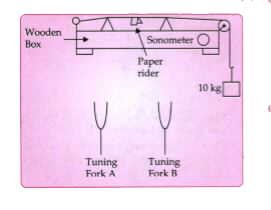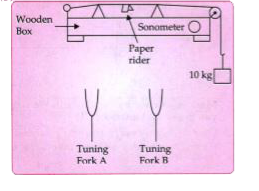Using suitable diagram explain how sound wave propagates through air from a vibrating tuning fork?
To explain how sound waves propagate through air from a vibrating tuning fork, we can break down the process into a series of steps and illustrate it with a suitable diagram.
1. Understanding the Tuning Fork:
- A tuning fork consists of two prongs that vibrate when struck. These vibrations create sound waves in the surrounding air.
- When the prongs of the tuning fork move outward, they compress the air molecules in front of them, creating areas of high pressure known as compressions.
2. Compressions and Rarefactions:
- As the prongs move outward, they push air molecules closer together, resulting in a compression.
- When the prongs move back inward, they create a low-pressure area as air molecules are pulled apart, resulting in a rarefaction.
- This cycle of compressions and rarefactions continues as long as the tuning fork vibrates.
3. Diagram Representation:
- Draw a tuning fork in the center of your diagram.
- Illustrate the prongs of the tuning fork vibrating outward and inward.
- Use arrows to indicate the direction of the wave propagation.
- Represent compressions (C) as closely spaced lines and rarefactions (R) as widely spaced lines.
- The diagram should show a series of compressions and rarefactions propagating away from the tuning fork.
4. Direction of Sound Propagation:
- Indicate the direction of sound wave propagation with arrows pointing away from the tuning fork.
- Label the regions of compression and rarefaction along the path of the sound wave.
5. Conclusion:
- The sound wave travels through the air as a series of compressions and rarefactions, allowing the sound to reach our ears.
Diagram:
|||||||||||||||C||C||C||||||||||||||||||||||||||||||||||||||R||R||R|||||||||||||||||||||||||||||||||||||||||||||||||||||||||||||||||||||||||||||||||||||||||||∣|||||||||||||||||||||||||||||||||||||||||||||||||||||||||||||||||||||||||||||||||||||||||||||||∣|||||||||||||||||||||||||||∣|∣|
- A tuning fork consists of two prongs that vibrate when struck. These vibrations create sound waves in the surrounding air.
- When the prongs of the tuning fork move outward, they compress the air molecules in front of them, creating areas of high pressure known as compressions.
- As the prongs move outward, they push air molecules closer together, resulting in a compression.
- When the prongs move back inward, they create a low-pressure area as air molecules are pulled apart, resulting in a rarefaction.
- This cycle of compressions and rarefactions continues as long as the tuning fork vibrates.
- Draw a tuning fork in the center of your diagram.
- Illustrate the prongs of the tuning fork vibrating outward and inward.
- Use arrows to indicate the direction of the wave propagation.
- Represent compressions (C) as closely spaced lines and rarefactions (R) as widely spaced lines.
- The diagram should show a series of compressions and rarefactions propagating away from the tuning fork.
- Indicate the direction of sound wave propagation with arrows pointing away from the tuning fork.
- Label the regions of compression and rarefaction along the path of the sound wave.
- The sound wave travels through the air as a series of compressions and rarefactions, allowing the sound to reach our ears.
|||||||||||||||C||C||C||||||||||||||||||||||||||||||||||||||R||R||R|||||||||||||||||||||||||||||||||||||||||||||||||||||||||||||||||||||||||||||||||||||||||||∣|||||||||||||||||||||||||||||||||||||||||||||||||||||||||||||||||||||||||||||||||||||||||||||||∣|||||||||||||||||||||||||||∣|∣|
Topper's Solved these Questions
- BOOK - ICSECHAPTER - WAVESEXERCISE - Superposition Of Waves, Beats, Stationary Waves55videos
WAVES
- BOOK - ICSECHAPTER - WAVESEXERCISE - Doppler Effect, Musical, Sound, Noise26videos
WAVES
- BOOK - ICSECHAPTER - WAVESEXERCISE - Long Answer Questions16videos
WAVES
- BOOK - ICSECHAPTER - VECTORS SCALARS ELEMENTARY CALCULUS EXERCISE - UNSOLVED PROBLEMS79videos
VECTORS SCALARS ELEMENTARY CALCULUS
Similar Questions
Explain how sound is propagated as a longitudinal wave .
View SolutionDraw diagrams to show the loop formation in a vibrating tuning fork.
View SolutionWhen a sound wave travels from water to air , it
View Solution(a) Draw diagrams to show the longitudinal mode of vibration and transverse mode of vibration of an electrically maintained tuning fork in the Melde's experiment.
(b) Indicate with the help of a diagram the positions of nodes and antinodes on a vibrating tuning fork.View SolutionExplain why transver waves cannot be propagated through fluids?
View SolutionThe diagram below shows a wire stretched over a sonometer. Stems of two vibrating tuning forks A and B are touched in turn to the wooden box of the sonometer. It is observed that the paper rider (a small piece of paper folded at the centre) present on the wire flies off when the stem of vibrating tuning fork B is touched to the wooden box but the paper just vibrates when the stem of vibrating tuning fork A is touched to the wooden box.

Name the phenomenon when the paper rider just vibrates.View SolutionWhen a tuning fork (vibrating) is held close to ear, one hears a faint hum. The same (vibrating tuning fork) is held such that its stem is in contact with the table surface, then one hears a loud sound. Explain.
View Solution
The diagram above shows a wire stretched over a sonometer. Stems of two vibrating tuning forks A and B are touched to the wooden box of the sonometer. It is observed that the paper rider (a small piece of paper folded at the centre) present on the wire flies off when the stem of vibrating tuning fork B is touched to the wooden box but the paper just vibrates when the stem of vibrating tuning fork A is touched to the wooden box.
Why does the paper rider fly off when the stem of tuning fork B is touched to the box ?View Solution
The diagram above shows a wire stretched over a sonometer. Stems of two vibrating tuning forks A and B are touched to the wooden box of the sonometer. It is observed that the paper rider (a small piece of paper folded at the centre) present on the wire flies off when the stem of vibrating tuning fork B is touched to the wooden box but the paper just vibrates when the stem of vibrating tuning fork A is touched to the wooden box.
Name the phenomenon when the paper rider flies off.View SolutionA light pointer fixed to one prong of a tuning fork touches gnetly a smoked vertical plate. The fork is set vibrating and the plate is allowed to fall freely. 8 complete oscilllations are counted when the plate falls through 10cm.What is the frequency of the tuning fork?
View Solution

